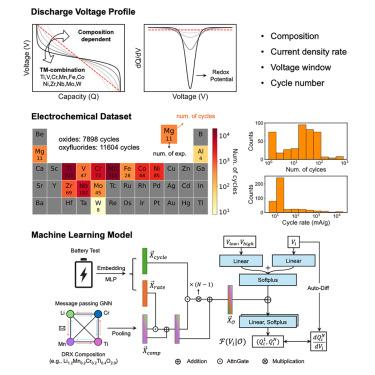Our official English website, www.x-mol.net, welcomes your
feedback! (Note: you will need to create a separate account there.)
Deep learning of experimental electrochemistry for battery cathodes across diverse compositions
Joule ( IF 38.6 ) Pub Date : 2024-04-10 , DOI: 10.1016/j.joule.2024.03.010 Peichen Zhong , Bowen Deng , Tanjin He , Zhengyan Lun , Gerbrand Ceder
Joule ( IF 38.6 ) Pub Date : 2024-04-10 , DOI: 10.1016/j.joule.2024.03.010 Peichen Zhong , Bowen Deng , Tanjin He , Zhengyan Lun , Gerbrand Ceder

|
Artificial intelligence (AI) has emerged as a tool for discovering and optimizing novel battery materials. However, the adoption of AI in battery cathode representation and discovery is still limited due to the complexity of optimizing multiple performance properties and the scarcity of high-fidelity data. We present a machine learning model (DRXNet) for battery informatics and demonstrate the application in the discovery and optimization of disordered rocksalt (DRX) cathode materials. We have compiled the electrochemistry data of DRX cathodes over the past 5 years, resulting in a dataset of more than 19,000 discharge voltage profiles on diverse chemistries spanning 14 different metal species. Learning from this extensive dataset, our DRXNet model can capture critical features in the cycling curves of DRX cathodes under various conditions. Our approach offers a data-driven solution to facilitate the rapid identification of novel cathode materials, accelerating the development of next-generation batteries for carbon neutralization.
中文翻译:

不同成分的电池阴极实验电化学的深度学习
人工智能(AI)已成为发现和优化新型电池材料的工具。然而,由于优化多种性能特性的复杂性和高保真数据的稀缺性,人工智能在电池正极表征和发现中的采用仍然受到限制。我们提出了一种用于电池信息学的机器学习模型(DRXNet),并演示了其在无序岩盐(DRX)正极材料的发现和优化中的应用。我们编译了过去 5 年 DRX 阴极的电化学数据,形成了涵盖 14 种不同金属种类的不同化学物质的 19,000 多个放电电压曲线的数据集。从这个广泛的数据集中学习,我们的 DRXNet 模型可以捕获各种条件下 DRX 阴极循环曲线的关键特征。我们的方法提供了数据驱动的解决方案,有助于快速识别新型正极材料,加速下一代碳中和电池的开发。
更新日期:2024-04-10
中文翻译:

不同成分的电池阴极实验电化学的深度学习
人工智能(AI)已成为发现和优化新型电池材料的工具。然而,由于优化多种性能特性的复杂性和高保真数据的稀缺性,人工智能在电池正极表征和发现中的采用仍然受到限制。我们提出了一种用于电池信息学的机器学习模型(DRXNet),并演示了其在无序岩盐(DRX)正极材料的发现和优化中的应用。我们编译了过去 5 年 DRX 阴极的电化学数据,形成了涵盖 14 种不同金属种类的不同化学物质的 19,000 多个放电电压曲线的数据集。从这个广泛的数据集中学习,我们的 DRXNet 模型可以捕获各种条件下 DRX 阴极循环曲线的关键特征。我们的方法提供了数据驱动的解决方案,有助于快速识别新型正极材料,加速下一代碳中和电池的开发。

































 京公网安备 11010802027423号
京公网安备 11010802027423号